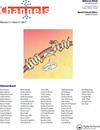炭疽热钙通道与PA相互作用的电生理证据
IF 3.2
3区 生物学
Q2 BIOCHEMISTRY & MOLECULAR BIOLOGY
引用次数: 0
摘要
三方炭疽毒素由无毒水肿因子(EF,钙调素/ ca2c依赖性腺苷酸环化酶)、致死因子(LF,锌依赖性金属肽酶裂解丝裂原活化蛋白激酶)和无毒PA (83 kDa)组成。在炭疽杆菌以单体形式释放后,它们在宿主细胞表面组装成有毒复合物。根据已建立的毒性作用机制,PA与细胞表面受体结合,促进由LF和EF组成的“致死毒素”的易位。两种PA受体先前已被鉴定,包括ATR/TEM8(炭疽毒素受体/肿瘤内皮标志物8)和CMG2(毛细血管形态发生蛋白2)。毒性作用的机制尚不清楚,除了PA与细胞表面受体结合并形成七聚体孔,参与“致命毒素”的易位。宿主靶细胞表面PA通道的形成是炭疽发病的关键步骤。PA需要结合一个常见的von Willebrand因子a(整合素样)插入结构域,该结构域包含由DxSxSx59-79Tx12-23D组成的MIDAS,其中x为任意氨基酸。MIDAS结构域存在于钙通道Cav1和Cav2家族的辅助a2d-1和a2d- 2亚基中。a2d、ATR/TEM8和CMG2的共同特征包括细胞外血管性血液病因子A结构域和单遍跨膜区。由于钙通道聚集在质膜上,它们可以很好地协同定位PA孔,使炭疽毒素充分进入细胞。与ATR/TEM8和CMG2不同,Cav1和Cav2钙通道存在于除免疫系统细胞和血细胞外的多种细胞中(尽管a2d存在于淋巴细胞中)。重要的是,它们在内皮细胞、角化细胞和成纤维细胞中表达,这些细胞代表了细菌进入的主要位置。鉴于钙通道a2d蛋白的广泛分布,我们假设a2d亚基可能与PA相互作用。这项研究提出了第一个实验证据,表明这种相互作用。膜片钳研究基本上与前面描述的8一样进行,重组人Cav1.2钙通道由荧光标记的血管/成纤维细胞成孔形成ECFPN-a1C,77 (z34815)亚基和副血管b3 (X76555)亚基组成,在Cos1细胞中与a2d±1 (AAA51903)共表达。在这些研究中,我们使用了PA的突变体PA- u7,其中furin切割位点被删除。PA-U7保留与受体结合的能力,但不能被蛋白水解激活。PA-U7的这一特性对膜片钳实验特别有用,因为PA-U7无法形成泄漏通道,否则会产生较大的非选择性泄漏电流,从而损害记录的特异性和膜片钳的稳定性。发现PA-U7在nM范围内抑制Ca2C电流(图1A)。虽然有数据表明PA-U7最终可能与受体分离,但我们没有观察到在用无pa缓冲液冲洗10分钟后钙通道抑制的显著逆转。较长的冲洗时间与全细胞膜片钳的稳定性不相容。在相同的条件下,失活的PA突变体PA- 3m在阻止与受体结合的结构域4中含有3个突变,没有诱导显着的Ca2C电流抑制(开圈)。的缓慢线性下降本文章由计算机程序翻译,如有差异,请以英文原文为准。
Electrophysiological evidences of interaction between calcium channels and PA of anthrax
Tripartite anthrax toxin is composed of nontoxic edema factor (EF, calmodulin/Ca2C-dependent adenylate cyclase), lethal factor (LF, a zinc-dependent metallopeptidase cleaving mitogen activated protein kinases) and non-toxic PA (83 kDa). On release from the anthrax bacillus as monomers, they assemble into toxic complexes on the surface of host cells. According to the established mechanism of toxic effect, PA binds to the cell surface receptors and facilitates the translocation of a “lethal toxin” composed of LF and EF. Two PA receptors have been previously identified, including ATR/TEM8 (anthrax toxin receptor/tumor endothelial marker 8 ) and CMG2 (capillary morphogenesis protein 2 ). Mechanism of toxic effect is not well known, except that PA binds to the cell surface receptors and forms heptameric pores that are involved in translocation of the “lethal toxin." The formation of PA channels on the surface of a host target cell is a key step in the pathogenesis of anthrax. PA requires for binding a common von Willebrand factor A (integrin-like) inserted domain that contains MIDAS composed of DxSxSx59–79Tx12–23D, where x is any amino acid. The MIDAS domain is present in the accessory a2d-1 and a2d¡2 subunits of the Cav1 and Cav2 families of the calcium channel. Common features of a2d, ATR/TEM8 and CMG2 include an extracellular von Willebrand factor A domain and a single-pass transmembrane region. Because calcium channels are clustered in the plasma membrane, they suite well to co-localize the PA pores to allow for sufficient entry of anthrax toxin into the cells. Unlike ATR/TEM8 and CMG2, Cav1 and Cav2 calcium channels are present in a wide variety of cells of the body except cells of immune system and blood cells (although a2d is found in lymphocytes). Importantly, they are expressed in endothelial cells, keratinocytes and fibroblasts, which represent the primary locations for bacterial entry. Given the wide distribution of calcium channel a2d proteins, we hypothesize that the a2d subunit may interact with PA. This study presents the first experimental evidence suggesting such an interaction. The patch clamp study was carried out essentially as described earlier 8 with the recombinant human Cav1.2 calcium channels composed of the fluorescently labeled vascular/fibroblast pore-forming ECFPN-a1C,77 (z34815) subunit and accessory vascular b3 (X76555) subunit co-expressed with a2d¡1 (AAA51903) in Cos1 cells. In these studies we used PA-U7, the mutant of PA where the furin cleavage site was deleted. PA-U7 retains ability to bind to receptors but cannot be proteolytically activated. This property of PA-U7 is particularly useful for patch clamp experiments because PA-U7 is unable to form leak channels that would otherwise compromise the specificity of recordings and stability of patch clamp by generating a large non-selective leak current. It was found that PA-U7 inhibited the Ca2C current in a nM range (Fig. 1A). Although there are data that PA-U7 may eventually dissociate from receptors, we did not observe a significant reversal of the calcium channel inhibition after wash-out for 10 min with the PA-free buffer. Longer wash-out was incompatible with the stability of whole-cell patch clamp. Under the same conditions, the inactive PA mutant PA-3M that contains 3 mutations in domain 4 preventing binding to a receptor, did not induce notable inhibition of the Ca2C current (open circles). Slow linear decrease of the
求助全文
通过发布文献求助,成功后即可免费获取论文全文。
去求助
来源期刊

Channels
生物-生化与分子生物学
CiteScore
5.90
自引率
0.00%
发文量
21
审稿时长
6-12 weeks
期刊介绍:
Channels is an open access journal for all aspects of ion channel research. The journal publishes high quality papers that shed new light on ion channel and ion transporter/exchanger function, structure, biophysics, pharmacology, and regulation in health and disease.
Channels welcomes interdisciplinary approaches that address ion channel physiology in areas such as neuroscience, cardiovascular sciences, cancer research, endocrinology, and gastroenterology. Our aim is to foster communication among the ion channel and transporter communities and facilitate the advancement of the field.
 求助内容:
求助内容: 应助结果提醒方式:
应助结果提醒方式:


